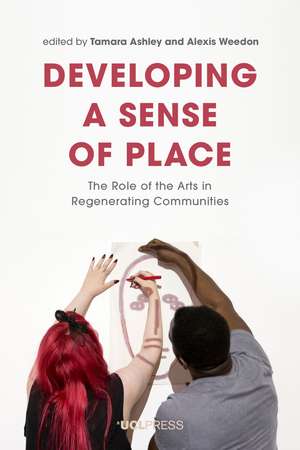Developing a Sense of Place: The Role of the Arts in Regenerating Communities
Editat de Tamara Ashley, Alexis Weedonen Limba Engleză Hardback – 14 mar 2021
Developing a Sense of Place offers a range of viewpoints, including those of the arts strategist, the academic, the practice-researcher, and the artist. Through its innovative models, from performing arts to architectural design, the book serves diverse interests, such as the arts and cultural policy managers, master planners, and arts workers, as well as students of human geography, cultural planning, business and the creative industries, and arts administration, at the undergraduate and postgraduate levels.
Preț: 376.35 lei
Nou
Puncte Express: 565
Preț estimativ în valută:
72.02€ • 74.92$ • 59.46£
72.02€ • 74.92$ • 59.46£
Carte disponibilă
Livrare economică 24 martie-07 aprilie
Livrare express 08-14 martie pentru 43.43 lei
Preluare comenzi: 021 569.72.76
Specificații
ISBN-13: 9781787357822
ISBN-10: 1787357821
Pagini: 322
Ilustrații: 19 halftones
Dimensiuni: 156 x 234 x 25 mm
Greutate: 0.64 kg
Editura: UCL Press
Colecția UCL Press
ISBN-10: 1787357821
Pagini: 322
Ilustrații: 19 halftones
Dimensiuni: 156 x 234 x 25 mm
Greutate: 0.64 kg
Editura: UCL Press
Colecția UCL Press
Notă biografică
Tamara Ashley is a senior lecturer at the University of Bedfordshire. Alexis Weedon is UNESCO chair and professor of publishing at the University of Bedfordshire.
Cuprins
"List of figures
List of tables
Notes on contributors
Foreword by Hedley Roberts
Acknowledgements
Introduction: Sensing place, a moment to reflect
Tamara Ashley and Alexis Weedon
Section 1: Case studies of place-making
1. Eastern Angles: A sense of place on stage
Ivan Cutting
2. Lesson drawing and community engagement: The experience of Take A Part in Plymouth
Kim Wide and Rory Shand
3. Raising the Barr
Sanna Wicks
4. Interview with E17 Art Trail directors Laura Kerry and Morag McGuire
Alexis Weedon
Section 2: Models and methods for developing place-making through the arts
5. A model for university–town partnership in the arts: TestBeds
Emma-Rose Payne and Alexis Weedon
6. The Beam archive, Wakefield
Kerry Harker
7. This Is Not My House: Notes on film-making, photography and my father
David Jackson
8. Notions of place in relation to freelance arts careers: A study into the work of independent dancers
Rachel Farrer and Imogen Aujla
Section 3: Multidisciplinary approaches to place and contested identities
9. Performing places: Carnival, culture and the performance of contested national identities
Jonathan Croose
10. A sense of place: From experience to language, from the Polish traveller through a Spanish saint to an adaptation of a Zimbabwean play
Agnieszka Piotrowska
11. The EU migrant: Britain’s sense of place in English newspaper journalism
Paul Rowinski
12. Rethinking the photographic studio as a politicised space
Caroline Molloy
13. Creative routine and dichotomies of space
Philip Mile
14. Doing things differently: Contested identity across Manchester’s arts culture quarters
Peter Atkinson
15. First, second and third: Exploring Soja’s Thirdspace theory in relation to everyday arts and culture for young people
Steph Meskell-Brocken
16. A sense of play: (Re)animating place through recreational distance running
Kieran Holland
17. Shiftless Shuffle from Luton: An interview with Perry Louis
Jane Carr
Afterword by Tamara Ashley and Alexis Weedon
Index "
List of tables
Notes on contributors
Foreword by Hedley Roberts
Acknowledgements
Introduction: Sensing place, a moment to reflect
Tamara Ashley and Alexis Weedon
Section 1: Case studies of place-making
1. Eastern Angles: A sense of place on stage
Ivan Cutting
2. Lesson drawing and community engagement: The experience of Take A Part in Plymouth
Kim Wide and Rory Shand
3. Raising the Barr
Sanna Wicks
4. Interview with E17 Art Trail directors Laura Kerry and Morag McGuire
Alexis Weedon
Section 2: Models and methods for developing place-making through the arts
5. A model for university–town partnership in the arts: TestBeds
Emma-Rose Payne and Alexis Weedon
6. The Beam archive, Wakefield
Kerry Harker
7. This Is Not My House: Notes on film-making, photography and my father
David Jackson
8. Notions of place in relation to freelance arts careers: A study into the work of independent dancers
Rachel Farrer and Imogen Aujla
Section 3: Multidisciplinary approaches to place and contested identities
9. Performing places: Carnival, culture and the performance of contested national identities
Jonathan Croose
10. A sense of place: From experience to language, from the Polish traveller through a Spanish saint to an adaptation of a Zimbabwean play
Agnieszka Piotrowska
11. The EU migrant: Britain’s sense of place in English newspaper journalism
Paul Rowinski
12. Rethinking the photographic studio as a politicised space
Caroline Molloy
13. Creative routine and dichotomies of space
Philip Mile
14. Doing things differently: Contested identity across Manchester’s arts culture quarters
Peter Atkinson
15. First, second and third: Exploring Soja’s Thirdspace theory in relation to everyday arts and culture for young people
Steph Meskell-Brocken
16. A sense of play: (Re)animating place through recreational distance running
Kieran Holland
17. Shiftless Shuffle from Luton: An interview with Perry Louis
Jane Carr
Afterword by Tamara Ashley and Alexis Weedon
Index "
